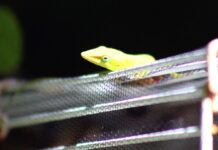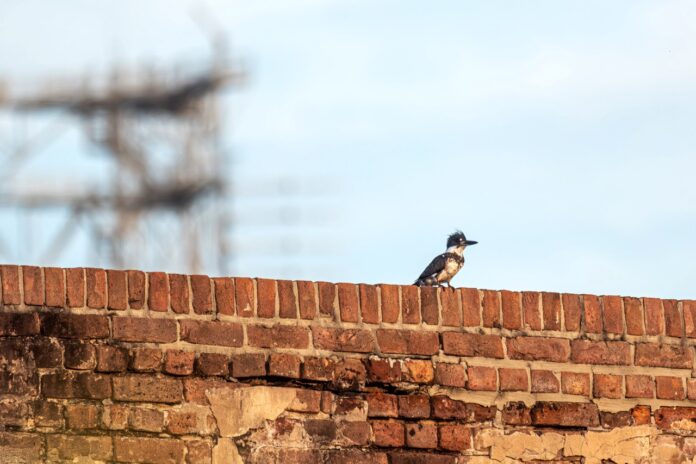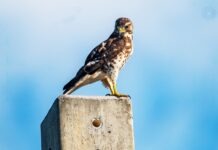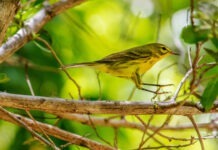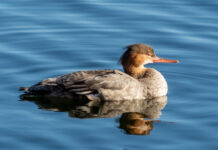The belted kingfisher was making a series of runs down the moat at Fort Zach, complaining pretty much every time it flapped along the outside of the half-hexagon of the fort’s brick facade, which was kind of expected.
Belted kingfishers are some of nature’s greatest malcontents. They are innately, and seemingly constantly, disgruntled, especially when compared to other species of birds that seem, as a group, to be largely gruntled. It’s their call that gives this impression, long and staccato and loud, sounding a bit like an air-powered machine gun shooting out a clip full of glass marbles. Ratta ratta ratta ratta. (The impression their call makes in other people’s brains may vary.)
I’ve always thought John James Audubon’s description of their shape was pretty apt: “Head large, neck short, body robust.” It should be added that their plumage is a mix of white and a slaty Wedgwood blue, and that they have this great spiky crest on their head, which also makes them seem a little unhinged. In the bird world, if a species’ genders aren’t nearly identical, the males are usually the more colorful ones. But the belted kingfisher is something of a gender bender, where the female actually has a mahogany band – or belt – across her chest, making her the more colorful one.
You generally hear belted kingfishers before you see them, though. And when you see them, they are generally flying away, at least if you’re on foot. If you’re driving past them while they are sitting on a wire near a highway, they don’t seem much bothered. But park your car and open your door, and they will be leaping off their perch and flying in the opposite direction – a long stream of avian invective trailing behind them – usually before you have time to lift your binoculars.
Belted kingfishers are piscivores, feeding primarily on small fish swimming less than two feet below the surface. They are one of the few species that can hover in midair, their body, wings and tail constantly adjusting, their head staying rock steady. But they will also perch on tree branches or, more often in the Keys, on utility lines next to calm water, to spot prey. And then they will dive into the water, snatch it up, come back to their perch, and beat the fish against the wire or branch on which they are sitting until it stops wriggling. Then they will toss it up and gulp it down.
In order to spot their small, fast-moving prey, often from something of a distance, they have forward-facing eyes and some serious binocular vision, superior to humans and on par with some hawks and falcons. The point being, they are built to see you coming, and they always do.
They are also loners. There is no such thing as a flock of belted kingfishers. There is no belted kingfisher jamboree. The only time they seek, or even tolerate, the close presence of other birds is when they are mating and raising young – about 25% of the year. The rest of the time they prefer their solitude.
It is, no doubt, anthropomorphic to consider belted kingfishers to be malcontents. We have no idea what a belted kingfisher’s worldview – or umwelt, if you want to use the current scientific term – is. Or what its emotional state is. But they only seem to make their loud, repetitive racket when disturbed and leaving a scene. Or if they fly back past the scene they just left and whoever or whatever disturbed them is still there. Theirs is a song of unwelcoming. It is a song of wanting you to leave.
It’s hard to take that as anything other than a complaint. Especially since they never actually get aggressive with people or other birds not of their species. They just leave loudly. You get the feeling that if doors were common in their world, and they could figure out a way to slam them, they would.
Kenn Kaufman, noted bird expert and Arnold Schwarzenegger fan, once pointed out that most of the decent photos you see of belted kingfishers are of young birds taken in the late summer or early fall, and when they’re only a couple months old. “Apparently their elusive, wary behavior is learned through experience,” he wrote in a piece for Audubon Magazine.
That experience has usually been gained by the time they make it to South Florida for the winter.
I’ve been seeing kingfishers all season, on wires and the occasional mangrove, passing them by without giving them much thought because a distant look is all you will get, and I’ve had a lot of distant looks.
But walking around the moat at Fort Zach I heard the rattle call and caught sight of the bird flying away from me and toward the Navy end of the moat. A few minutes later it flew by again – yes, still complaining – and flew towards the end of the moat near the blacksmith shop.
When I bought my first big camera lens – a 400mm, but on a crop-censored camera, meaning it was the equivalent of a 640mm lens – I thought, that’s it, now I can take a good picture of anything, any bird, no matter how far away it is. Which I quickly learned was not the case. No lens is ever big enough to capture everything. Or even most things.
I’ve never managed to get a decent shot of a belted kingfisher. But this one bird, despite its complaints, didn’t seem inclined to leave the moat area. For some reason I thought that, if I was patient enough, I had a chance, for once, at a decent shot.
So I spent some time standing there. Half an hour, 45 minutes. I’m not totally sure. Occasionally the bird would fly by and I would try to get a shot of it in the air and miss. Or it would land on the wall and I would lean out from the bush I was hiding behind and lift my camera, and it would take off before I could bring it to my eye.
The light was fading but eventually I managed to get a shot or two of the kingfisher sitting high on the fort wall. Not great shots, but shots where you at least knew it was the eternally peevish belted kingfisher.
I told myself in the moment that not everything needs to be easily attainable. Maybe it’s good for some things to be hardly attainable at all. The important thing is not to become a malcontent yourself.







